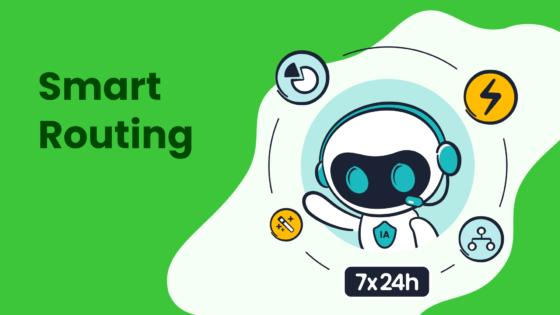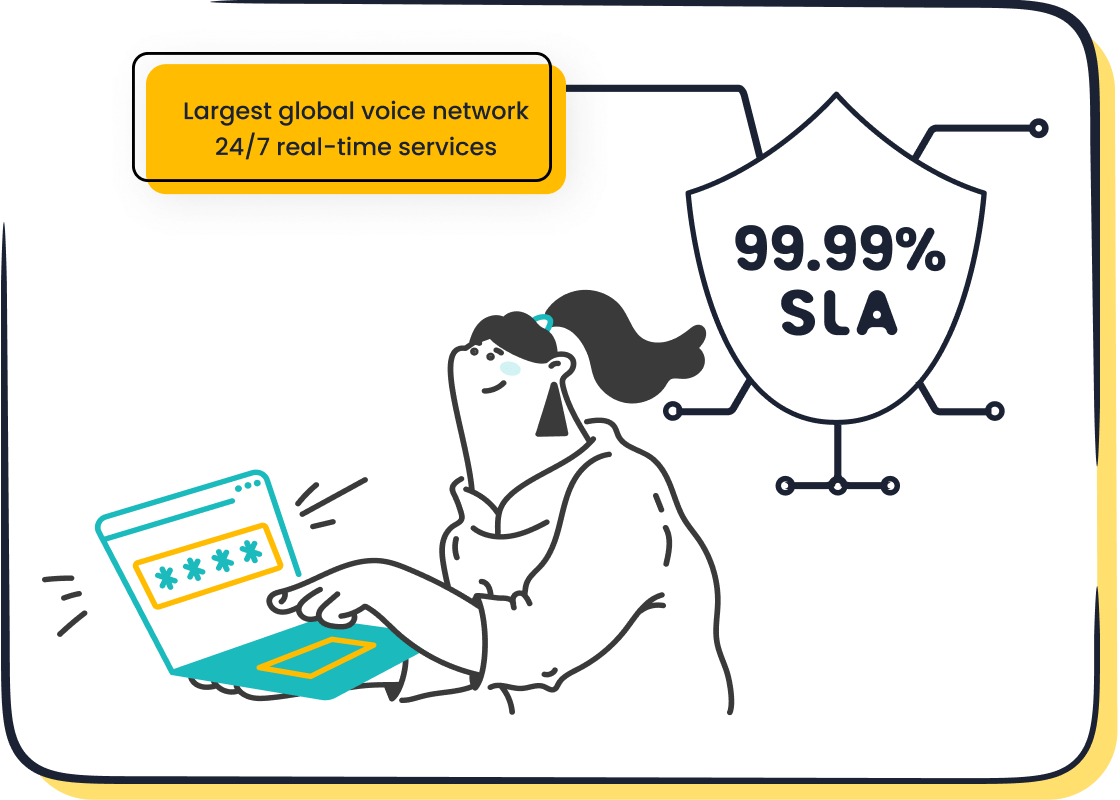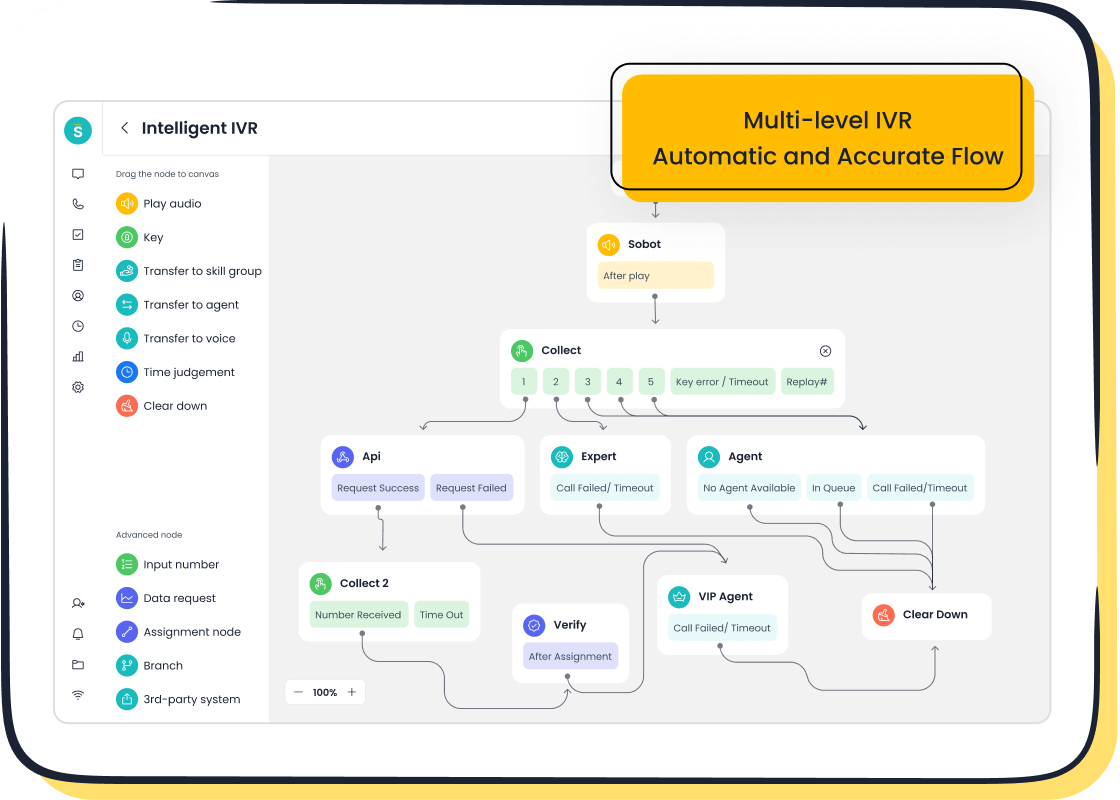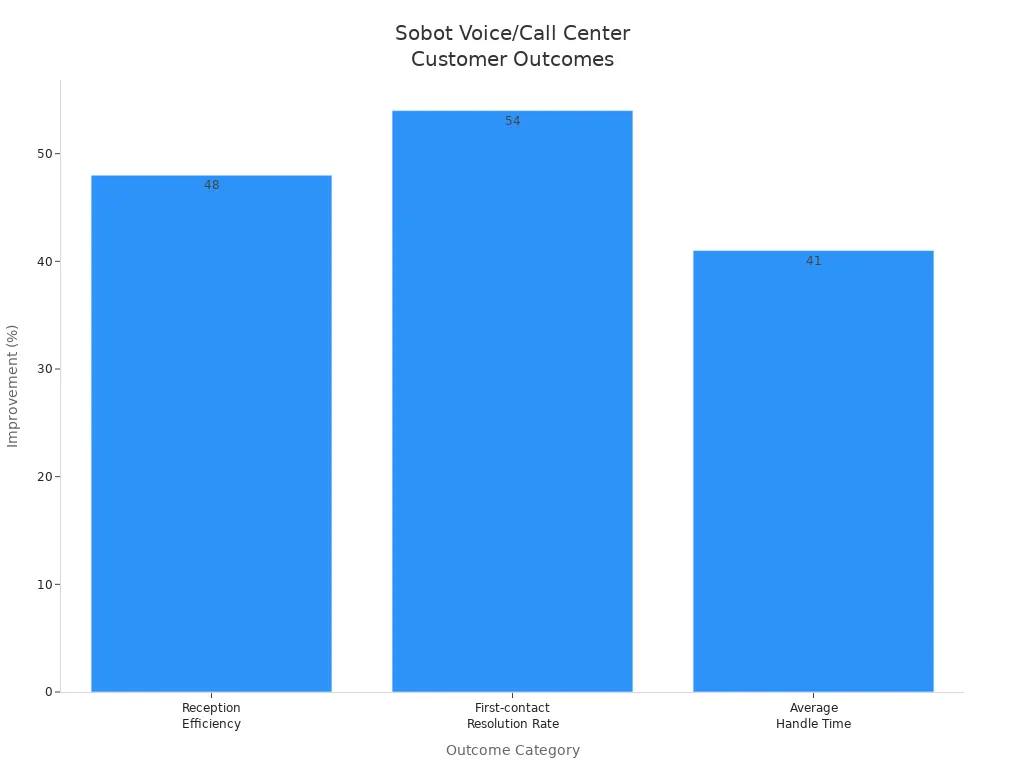Best Practices for Deploying Call Center Virtual Agents in 2025

Adopting best practices for deploying a call center virtual agent in 2025 drives customer satisfaction and operational efficiency. You see more businesses using strategies that rely on advanced AI and chatbot technology. The table below shows how the adoption of virtual agents and chatbots continues to rise:
| Statistic / Insight | Value / Description |
|---|---|
| Chatbot adoption increase | From 36% in 2022 to 37.5% in 2023 |
| Projected automation of agent interactions by 2026 | 1 in 10 interactions (10%), up from 1.6% in 2022 |
| Percentage of global business leaders expecting efficiency boost from generative AI | 56% |
| Contact center professionals aiming to implement AI for customer satisfaction | 31.6% |
Sobot AI and Sobot call center solutions help you deploy chatbots that improve customer service, speed up resolution, and raise customer satisfaction. With these strategies, you can achieve up to 52% faster ticket handling and reduce costs by 30%. When you follow best practices, you empower your team to deliver virtual support that meets the highest standards for satisfaction and efficiency.
Objectives and Metrics

Setting Goals
You need clear goals before deploying virtual agents in your call center. The SMART framework helps you set objectives that are specific, measurable, attainable, relevant, and time-based. For example, you might aim to improve customer satisfaction scores or reduce average handle time. You can use real-time analytics dashboards to track progress and keep your team engaged. Sobot’s Voice/Call Center product supports these goals by providing actionable insights and easy access to performance data. You can set targets for first call resolution, lower abandon rates, and boost Net Promoter Scores. When you align your goals with business priorities, you create a foundation for successful customer interactions and efficient operations.
Tip: Integrate SMART goals into agent training and feedback sessions. This approach helps you identify skill gaps and improvement opportunities quickly.
| Example SMART Goal | Description |
|---|---|
| Improve CSAT by 10% | Use sentiment analysis and customer feedback to guide improvements |
| Reduce AHT by 15% | Apply analytics to streamline workflows and automate routine tasks |
| Increase bot containment rate | Enhance virtual agent responses for more effective customer interactions |
Measuring Success
You measure success by tracking key performance metrics. These metrics reveal how well your virtual agents handle customer interactions and deliver value. Use analytics to monitor customer satisfaction (CSAT), first call resolution (FCR), and service level. Sentiment analysis helps you understand how customers feel during interactions. You should also track average handle time, abandon rate, and cost per contact. Sobot’s unified workspace provides real-time insights and analysis, making it easy to spot trends and optimize performance. Monitor bot containment rates to see how many inquiries your virtual agents resolve without human intervention. Collect agent feedback on AI recommendations to refine your virtual agent support. Regular analysis of unhandled queries and performance data helps you identify new topics and improve your knowledge base. When you use analytics and insights effectively, you drive better outcomes for both your customers and your business.
- Key metrics to track:
- Customer satisfaction (CSAT)
- First call resolution (FCR)
- Service level
- Average handle time (AHT)
- Abandon rate
- Cost per contact
- Bot containment
- Sentiment analysis
- Agent AI feedback
Choosing Call Center Virtual Agent Technology
Selecting the right call center virtual agent technology shapes your customer experience and operational efficiency. You need a solution that combines advanced ai tools, robust automation, and seamless integration. Sobot’s Voice/Call Center product stands out with features designed for modern enterprises.

Sobot Voice/Call Center Features
Sobot’s Voice/Call Center platform offers a unified workspace, intelligent IVR, and an ai-powered voicebot. You can manage inbound and outbound calls, automate routine tasks, and access real-time analytics. The drag-and-drop IVR builder lets you customize call flows quickly. With global number availability and 99.99% uptime, you ensure reliable service for customers worldwide. Sobot’s encrypted data transfer and compliance with international standards protect your customer information. The platform supports both mobile and desktop, giving your agents flexibility.
| Feature Category | Details and Differentiators |
|---|---|
| User-friendliness | Intuitive interface for fast onboarding and daily use. |
| Integration | Simple, fast connection with CRM and business systems. |
| AI Capabilities | Advanced monitoring, speech-to-text, and data analytics. |
| Global Infrastructure | 110 sites in 93 cities, 50 countries. |
| Reliability | 99.99% uptime, stable service. |
| Customer Outcomes | 48% higher reception efficiency, 54% better first-contact resolution, 41% lower handle time. |

AI Capabilities
You benefit from ai tools that power your call center chatbot and virtual agent solutions. Sobot’s ai-powered chatbot handles multi-channel inquiries, automates repetitive tasks, and integrates with human teams. Intelligent routing assigns calls to the best agent, reducing wait times. AI-enabled summarization creates concise call summaries, saving agent time. Automated agent evaluation and voice of the customer insights help you improve service quality. Real-time speech monitoring and multilingual chat translation ensure high-quality support for diverse customers. These ai tools drive automation, boost efficiency, and enhance customer satisfaction.
Scalability
Your call center virtual agent must scale with your business. Sobot’s ai tools and automation handle thousands of simultaneous interactions, eliminating wait times during peak hours. The platform’s integration with CRM and other systems ensures smooth data flow. Multilingual support and emotion-aware conversations maintain service quality across regions. Automation of FAQs and routine tasks reduces agent workload, letting your team focus on complex issues. Flexible, on-demand staffing models and partnerships with BPOs help you manage fluctuating call volumes. Sobot’s robust infrastructure and ai-driven automation keep your call center chatbot running smoothly, no matter the demand.
Integration Best Practices
CRM and System Integration
You achieve seamless integration by following best practices that align virtual agents with your existing CRM and business systems. Sobot’s Voice/Call Center product simplifies this process, offering compatibility with popular CRM platforms and business tools. You start by assessing your organization’s needs, identifying pain points such as manual data entry or slow response times. Choose an AI solution that supports multi-channel communication and integrates smoothly with your workflows. Sobot’s drag-and-drop interface and API connectors allow you to link systems quickly, reducing complexity and boosting efficiency. You prepare your team for workflow changes, emphasizing that AI enhances human roles. Integration with CRM, ERP, and other systems ensures real-time insights and avoids duplicated efforts. You tailor use cases to your industry, whether automating FAQs in customer service or streamlining appointment scheduling in healthcare.
Tip: Address integration complexity by conducting compatibility assessments and using custom APIs when needed. This approach helps you navigate diverse software ecosystems and maintain smooth data flow.
Data Synchronization
Accurate data synchronization is essential for virtual agent implementation. You connect Sobot’s virtual agents to your knowledge bases and backend systems using secure APIs. Map CRM fields to conversation contexts to maintain data consistency. Test connections with sample data flows to verify accuracy. Sobot’s encrypted data transfer protects sensitive information and supports compliance with global standards. You train chatbots with cleaned historical data, such as past chat logs and call transcripts, to improve response quality. Run A/B tests and monitor initial conversations to detect misunderstanding patterns. Update training data regularly to adapt to new terms and slang. Real-time insights from Sobot’s monitoring tools help you identify bottlenecks and optimize performance, ensuring efficiency and reliability.
- Key steps for data synchronization:
- Link virtual agents to backend systems via APIs
- Map CRM fields for consistency
- Test with sample data flows
- Establish fallback protocols for outages
- Train with historical data
Testing and Deployment
You ensure successful implementation by adopting robust testing and deployment strategies. Simulate diverse user environments to test agent responses under different moods and states. Conduct layered behavioral testing, including goal achievement and decision boundary checks. Use sandbox environments to avoid impacting production data. Sobot supports phased deployment, allowing you to release functions incrementally and reduce risk. Monitor agent responses post-deployment and refine based on user feedback. Continuous testing and refinement improve conversion rates and reduce errors. Tie KPIs to agent goals, such as reducing average handle time or improving first call resolution. Real-time insights from Sobot’s analytics dashboards provide actionable data to optimize operations and enhance efficiency.
| Strategy | Description | Importance |
|---|---|---|
| Phased deployment | Release functions incrementally | Reduces risk and enables improvement |
| Continuous testing | Routinely test routing and messaging | Ensures ongoing adaptation |
| KPI monitoring | Track metrics like FCR and CSAT | Optimizes performance |
Enhancing Customer Experience with Chatbots

Conversational Flows
You improve customer experience by designing effective conversational flows for your call center chatbot. Start by defining the chatbot’s purpose and mapping out user journeys. Use natural language processing (NLP) to understand customer intent and keep conversations on track. Flexible flows adapt to changing needs and prevent dead-ends. Clear prompts and fallback responses help guide users through customer inquiries. Regularly monitor performance and update flows to match trends in customer interactions. This approach ensures your chatbot delivers fast, accurate responses and keeps satisfaction high.
Tip: Visualize conversation paths with wireframes to spot gaps and improve user experience.
Escalation to Agents
Your call center chatbot must know when to transfer customer interactions to human agents. Set clear escalation rules based on sentiment, intent, or language triggers. For example, if a customer expresses frustration or asks a complex question, the chatbot should hand off the conversation. Provide agents with full context so they can resolve issues quickly. Use no-code escalation policies to update rules as your business evolves. Monitor handoff metrics like time-to-resolution and customer satisfaction to refine your process. This seamless transition ensures that agents handle sensitive or complex customer inquiries, maintaining high satisfaction.
- Define escalation triggers for your chatbot.
- Prepare agents with conversation history.
- Track handoff outcomes to improve future interactions.
Personalization
Personalization in your call center chatbot interactions boosts customer satisfaction and loyalty. AI-driven chatbots use customer data to tailor responses, recommend solutions, and remember preferences. When your chatbot mimics human-like communication and delivers relevant information, customers feel valued. Studies show that high-quality, personalized chatbot interactions lead to greater satisfaction and repeat business. Ethical design also matters—customers trust chatbots that handle their data responsibly. By combining AI efficiency with a personal touch, you create a customer service experience that stands out.
| Feature | AI Chatbots / AI Call Centers | Traditional Call Centers (Human Agents) |
|---|---|---|
| Availability | 24/7 service, no downtime | Limited to staffing hours |
| Call Volume Handling | Can handle very high volumes without fatigue | Limited by number and capacity of staff |
| Operational Costs | Lower due to automation and reduced staffing needs | Higher due to salaries, training, and human resources |
| Personalization | Handles routine inquiries well | High empathy and personalized emotional engagement |
| Training Needs | Minimal ongoing training required | Continuous and often costly training |
| Scalability | Easily scalable to meet demand | Challenging to scale quickly due to staffing limits |
Your call center chatbot, powered by AI, delivers 24/7 support, handles high volumes, and reduces operational costs. This approach increases customer satisfaction and ensures your agents focus on complex customer service needs.
Data Security and Compliance
Privacy Standards
When you deploy a call center virtual agent, you must protect customer privacy at every step. Privacy standards set the foundation for secure operations. Each region enforces its own rules, so you need to stay informed and compliant. The table below highlights key privacy standards for major markets:
| Region | Mandatory Privacy Standards and Regulations |
|---|---|
| North America | PIPEDA, GLB Act, HIPAA, CCPA, HL7, OSHA, FISMA, NIST |
| Asia Pacific | PDPA, APPI, ISO 27001 |
| Middle East & Africa | Israeli Privacy Protection, GDPR (KSA), POPIA |
| Additional Standards | PCI DSS, Sarbanes-Oxley, SOC 2 Type II, ISO/IEC 27001, GLB Act |
You should always verify that your call center chatbot and virtual agent solutions, like those from Sobot, align with these standards. Sobot’s platform uses encrypted data transfer and complies with global privacy requirements, helping you maintain trust with your customers.
Regulatory Requirements
You face strict regulatory requirements when handling customer data through virtual agents. These rules protect sensitive information and ensure ethical practices. To meet these requirements, you must:
- Comply with regulations such as GDPR and HIPAA for data protection.
- Use strong authentication, including multi-factor authentication (MFA), especially for remote or mobile agents.
- Secure all communications with encryption and robust password policies.
- Choose software solutions that support compliance and regular monitoring.
- Train your team on privacy protocols and keep them updated on new regulations.
Sobot’s call center virtual agent platform supports these needs with encrypted data transfer, secure mobile access, and regular system updates. You can rely on Sobot to help you meet industry standards and regulatory demands.
Secure Handling
You must handle sensitive customer information with care. The most critical risks include outdated software, weak access controls, insecure payment processing, and improper data storage. To protect your call center virtual agent environment, follow these best practices:
- Encrypt all chat and call data end-to-end.
- Use secure forms and delete sensitive data after use.
- Mask sensitive details, such as showing only the last four digits of credit card numbers.
- Require agent authentication with MFA before accessing private data.
- Limit data collection to what is necessary for resolving issues.
- Obtain clear customer consent before collecting or using sensitive information.
- Conduct regular security audits and monitor access logs for suspicious activity.
- Keep all software updated and enable auto-updates.
- Train agents and virtual assistants on security protocols and breach response.
Note: Sobot’s solutions provide 99.99% uptime, encrypted data transfer, and global compliance, giving you peace of mind as you deploy advanced call center chatbots and virtual agents.
Continuous Improvement for Call Center Chatbot Performance
Monitoring Unhandled Queries
You need to monitor unhandled queries to keep your chatbot effective. When your ai tools miss customer inquiries or trigger fallback responses, you uncover gaps in your chatbot’s knowledge. High fallback rates and bot loops frustrate users and lower customer satisfaction. You should analyze conversation transcripts from abandoned sessions and review misunderstood queries. This process helps you identify missing intents and improve natural language understanding. Regular audits of your chatbot’s knowledge base, paired with sprint-like updates, keep content fresh and relevant. By addressing unhandled queries, you expand your chatbot’s ability to resolve more customer interactions accurately. This leads to higher resolution rates and better customer satisfaction. Use analytics to track intent recognition rates and aim for at least 90% accuracy. Combine quantitative data with qualitative user feedback for a complete view of your chatbot’s performance.
- Monitor fall-back rates and 'No Solution' intents.
- Review conversation logs for misunderstood queries.
- Update chatbot training data based on new customer interactions.
- Set regular optimization cycles with clear metrics.
Training with Real Scenarios
You improve chatbot performance by training with real customer scenarios. Educate your agents on best practices and simulate real conversations in controlled environments. Categorize common queries into intents using actual customer interactions. Incorporate real business examples to illustrate how your chatbot should handle different situations. Regularly collect and analyze recent customer data to spot new patterns and issues. Involve subject matter experts in the process to ensure your chatbot’s knowledge base stays accurate and comprehensive. This approach helps your ai tools deliver precise responses and handle complex customer interactions. Continuous updates to your chatbot’s training data keep it aligned with evolving customer needs. Use coaching sessions to review chatbot and agent performance, focusing on productivity and sentiment analysis.
- Simulate real conversations for training.
- Categorize queries based on actual customer interactions.
- Involve subject matter experts for accuracy.
- Update chatbot knowledge base with fresh data.
- Use coaching and qa sessions for ongoing improvement.
Feedback and Updates
You must gather feedback from multiple sources to keep your chatbot and ai tools effective. Collect user feedback through in-chat surveys, follow-up emails, and support ticket reviews. Analyze usage patterns and conversation logs to find areas for improvement. Prioritize feedback to target specific chatbot enhancements. Use both manual oversight and ai-driven analysis to interpret feedback and maintain ethical standards. Establish clear success metrics such as user satisfaction, resolution rate, engagement, and response accuracy. Conduct regular performance assessments and agile updates to your chatbot. This dynamic process ensures your chatbot adapts quickly to changing customer interactions and business needs. Encourage agents to share insights during coaching and qa sessions, fostering a culture of continuous learning and improvement. Integrate analytics dashboards to visualize trends and measure the impact of updates on productivity and sentiment.
Tip: Maintain a feedback loop with your agents and customers to ensure your chatbot evolves with every implementation cycle.
Supporting Agents in Hybrid Environments
Collaboration with Virtual Agents
You maximize productivity and efficiency when you structure collaboration between agents and virtual agents thoughtfully. Assign routine tasks to ai tools, such as handling repetitive inquiries or gathering customer information. This approach frees agents to focus on complex interactions that require empathy and problem-solving. Use agent assistance features in Sobot’s Voice/Call Center product to provide real-time data and ai suggestions during live interactions. The table below shows how you can balance responsibilities for optimal results:
| Aspect | Summary | Example Insight |
|---|---|---|
| Task Delegation | Assign repetitive tasks to ai tools, let agents handle complex issues | Virtual agents answer FAQs, agents resolve disputes |
| Mutual Responsiveness | Agents and ai tools respond to each other’s actions for seamless interactions | AI suggests solutions, agents personalize responses |
| Mixed-Initiative Control | Both agents and ai tools take initiative based on context | AI flags urgent cases, agents intervene as needed |
| Leveraging AI Capabilities | Use ai tools for analytics, sentiment analysis, and workflow automation | Agents receive real-time insights during calls |
You create a culture of shared commitment and support, which leads to better customer interactions and higher productivity.
Training and Motivation
You empower agents by providing continuous training and motivation. Develop training programs that cover technical skills, ai literacy, and soft skills like empathy. Use experiential learning, such as role-playing with virtual agents, to prepare agents for real interactions. Sobot’s cloud-based training tools allow agents to access resources anytime, supporting hybrid work environments. Set clear goals and standards, then reinforce them through workshops and practice calls. Motivate agents with gamification, storytelling, and regular feedback. Celebrate small wins to build momentum and maintain engagement. Equip agents with ai tools and agent assistance features to boost confidence and productivity. Encourage open communication and foster psychological safety, so agents feel comfortable sharing ideas and challenges.
Tip: Personalize motivation strategies to individual strengths and preferences. This approach increases satisfaction and drives better performance.
Change Management
You guide agents through change by implementing structured change management practices. Communicate the benefits of ai tools and virtual agent assistance clearly. Involve agents in the process by seeking feedback and addressing concerns. Provide equal access to resources, including quality equipment and IT support, for both remote and in-office agents. Use workforce management software to optimize scheduling and resolve conflicts across time zones. Promote cultural awareness and inclusivity through training and team activities. Monitor performance metrics such as customer satisfaction and call resolution time to measure progress. Maintain robust security and compliance protocols to protect sensitive data in hybrid environments. Sobot’s unified workspace and cloud-based systems support seamless transitions, helping agents adapt quickly and maintain high productivity.
You drive satisfaction by following proven strategies for deploying call center virtual agents. Sobot’s Voice/Call Center product helps you create a seamless chatbot experience, boosting customer satisfaction and operational efficiency. You use strategies like real-time monitoring, secure integration, and continuous improvement to keep your chatbot effective. Customer service teams see higher satisfaction when chatbots handle routine tasks, letting agents focus on complex needs. Looking ahead, you will see trends such as AI-augmented RPA, advanced NLP, and agentic AI shape the future of customer service:
- Human agents focus on high-value interactions while chatbots automate routine tasks.
- Generative AI boosts agent productivity and customer satisfaction.
- Enhanced security and empathy improve chatbot-driven customer service.
You set your business up for long-term satisfaction by adopting these strategies and leveraging Sobot’s advanced chatbot solutions.
FAQ
What is a call center virtual agent?
A call center virtual agent is an AI-powered tool that handles customer inquiries through voice or chat. You can use it to automate routine tasks, answer questions, and provide support 24/7. Sobot’s virtual agents help you improve efficiency and customer satisfaction.
How does Sobot integrate with my existing systems?
You connect Sobot’s call center virtual agent to your CRM and business tools using simple APIs. The platform supports fast integration, real-time data sync, and secure encrypted transfers. You can manage everything from a unified workspace.
Can Sobot’s chatbot handle multiple languages?
Yes, Sobot’s chatbot supports multilingual conversations. You can serve customers in different regions without language barriers. The AI-powered system recognizes and responds in various languages, ensuring a seamless customer experience worldwide.
How do I ensure data security with Sobot’s virtual agents?
Sobot uses encrypted data transfer, secure authentication, and compliance with global privacy standards. You protect customer information with 99.99% uptime and regular security updates. The platform meets requirements like GDPR and ISO 27001.
What results can I expect from deploying Sobot’s call center virtual agent?
You can expect faster response times, higher customer satisfaction, and reduced operational costs. Sobot’s clients report improved first-contact resolution and up to 52% faster ticket handling. The virtual agent lets your team focus on complex issues.
See Also
Effective Strategies For Managing Call Center Quality
Discover The Leading Cloud Contact Centers Of 2025
Comprehensive Overview Of Omnichannel Call Center Tools
